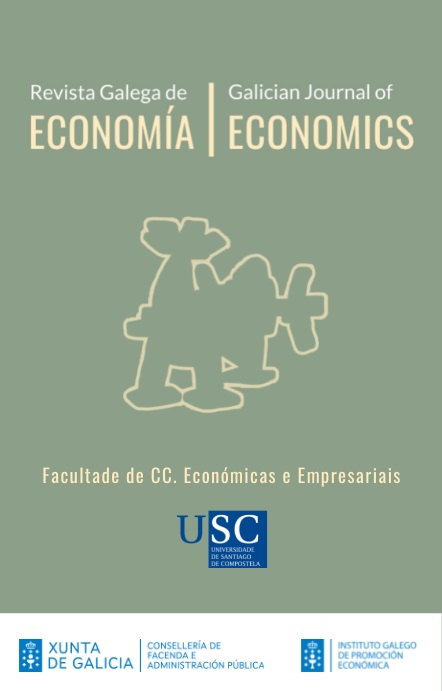Determinants and temporary changes in the distribution tourist expenditure between origin and destination. Evidence from the Canary Islands
Contido principal do artigo
Resumo
Tourism is the main source of wealth for many regions. These make their territory available to the tourist industry for the creation of infrastructures and facilities for tourist services. The peculiarities of the tourist product favor the appearance of intermediaries outside the destination, who compete to obtain a part of tourism spending, largely by the hand of new technologies, detracting resources to the destination that could be aimed at improving their growth and wellness. In the present paper, we use tourist data from the Canary Islands destination, covering the years 2006-2017, to study the share of the total tourist expenditure paid directly to the service provider in the destination, identifying their determinant variables and the evolution along of the studied years. The results show that the percentage of expenditure at the destination is affected by economic, sociodemographic, travel-related characteristics and with the ICT use but, ceteris paribus, this percentage is systematically decreasing over time, even when new technologies are used in the process of buying holidays.
Palavras-chave:
Detalles do artigo
Referências
Aguiló, E., e Juaneda, C. (2000). Tourist expenditure for mass tourism markets. Annals of Tourism Research, 7(3), 624-637. DOI: https://doi.org/10.1016/s0160-7383(99)00101-2
Alegre, J., Cladera, M., e Sard, M. (2011). Analysing the influence on tourist expenditure at a sun-and-sand destination. Tourism Economics, 17(4), 813-832. DOI: https://doi.org/10.5367/te.2011.0063
Alegre, J., Pou, L. (2008). Research note: Tourism expenditure and all-inclusive packages – The case of a mature mediterranean destination. Tourism Economics, 14(3), 645-655. DOI: https://doi.org/10.5367/000000008785633631
Basu, A., e Manca, A., (2012). Regression estimators for generic health-related quality of life and quality-adjusted life years. Medical Decision Making, 32(1), 56-69. DOI: https://doi.org/10.1177/0272989X11416988
Brida, J., e Scuderi, R. (2013). Tourism management perspectives. Tourism Management Perspectives, 6, 28-40. DOI: https://doi.org/10.1016/j.tmp.2012.10.006
Castellani, M., Pattitoni, P., e Scorcu, A., (2012). Visual artist price heterogeneity, Economics and Business Letters, 1(3), 16-22. DOI: https://doi.org/10.17811/ebl.1.3.2012.16-22
Castillo, E., Martínez, F., e Vázquez, E. (2015). O turismo en Ecuador. Novas tendencias no turismo sostible e contribución ao crecemento económico. Revista Galega de Economía, 24(2), pp. 69-84. Recuperado de http://www.usc.es/revistas/index.php/rge/article/view/2931
David-Negre, T., Hernández, J., e Moreno-Gil, S. (2018). Understanding tourists leisure expenditure at the destination: A social network analysis. Journal of Travel & Tourism Marketing, 35(7), 922-937. DOI: https://doi.org/10.1080/10548408.2018.1447533
Eurostat. (2018). Tourism statistics at regional level. Luxembourg, Luxembourg: Eurostat. Recuperado de https://ec.europa.eu/eurostat/statistics-explained/index.php/Tourism_statistics_at_regional_level
Exceltur. (2018). Impactur 2017. Estudio del impacto económico del turismo sobre la economía y el empleo de las Islas Canarias. Santa Cruz de Tenerife/Las Palmas de Gran Canaria: Gobierno de Canarias. Recuperado de https://www.exceltur.org/wp-content/uploads/2018/07/IMPACTUR-Canarias-2017.pdf
Ferrari, S., e Cribari-Neto, F. (2004). Beta regression for modelling rates and proportions, Journal of Applied Statistics, 31(7), 799-815. DOI: https://doi.org/10.1080/0266476042000214501
García, A., Artal, A., e Ramos, J.M. (2002). El turismo del Mar Menor: predominio de la segunda residencia. Cuadernos de Turismo, 9, 33-45. Recuperado de https://revistas.um.es/turismo/article/view/21981
Guisán, M.C. (2017). Desarrollo económico regional de España, 1986-2013. 25 años de evolución. Revista Galega de Economía, 26(2), 171-182. Recuperado de http://www.usc.es/revistas/index.php/rge/issue/view/332
Hviid, M., e Villadsen, B. (1995). Beta distributed market shares in a spatial model with an application to the market for audit services. Review of Industrial Organization, 10(6), 737-747.
ISTAC (varios anos): Encuesta sobre el gasto turístico. Las Palmas de Gran Canaria/Santa Cruz de Tenerife: Instituto Canario de Estadística.
Kastenholz, E. (2005). Analysing determinants of visitor spending for the rural tourist market in North Portugal. Tourism Economics, 11(4), 555-569. DOI: https://doi.org/10.5367/000000005775108728
Kieschnich, R., e MCCullough, B. D. (2003). Regresion analysis of variates observed on (0,1): percentages, proportions and fractions. Statistical Modelling, 3, 193-213. https://doi.org/10.1191/1471082X03st053oa
Man, R., e Liping, A. (2004). Information search behavior and tourist characteristics. Journal of Travel & Tourism Marketing, 17(2-3), 15-25.
Mok, C., e Iverson, J. (2000). Expenditure-Based segmentation: Taiwanese tourist to Guam. Tourism Management, 21(3), 299-305. DOI: https://doi.org/10.1016/s0261-5177(99)00060-6
Organización Mundial del Turismo. (2018): Why tourism? Tourism – An economic and social phenomenon. Madrid: Organización Mundial del Turismo.
Rodríguez, S., Dávila, C., Rodríguez, A., e Tejera, M. (2017). Factores asociados a los nuevos canales de compra del vuelo de turismo de sol y playa relacionados con TIC. Revista de Análisis Turístico, 24(2), 41-53. DOI: https://doi.org/10.1234/RAT2011n11
Sainaghi, R. (2012). Tourist expenditures: The state of the art. Anatolia, 23(2), 217-233. https://doi.org/10.1080/13032917.2012.684217
Salinas-Rodríguez, A., Pérez-Nuñez, R., e Ávila-Burgos, M., (2006). Modelos de regresión para variables expresadas como una proporción continua. Salud Pública de México, 48(5), 395-404. Recuperado de https://www.medigraphic.com/cgi-bin/new/resumen.cgi?IDARTICULO=12644
Smithson, M., e Verkuilen, J., (2006). A better lemon squeezer? Maximum-likelihood regression with betadistributed dependent variables. Psychological Methods, 11(1), 54-71. DOI: http://dx.doi.org/10.1037/1082-989X.11.1.54
Tyrrell, T., e Johnston, R. (2001). A framework for assessing direct economic impacts of tourist events: Distinguishing origins, destinations, and causes of expenditures. Journal of Travel Research, 40(1), 94-100. DOI: https://doi.org/10.1177/004728750104000112
Wang, Y., e Davidson, M. (2010). A review of micro-analyses of tourist expenditure. Current Issues in Tourism, 13(6), 507-524. https://doi.org/10.1080/13683500903406359






